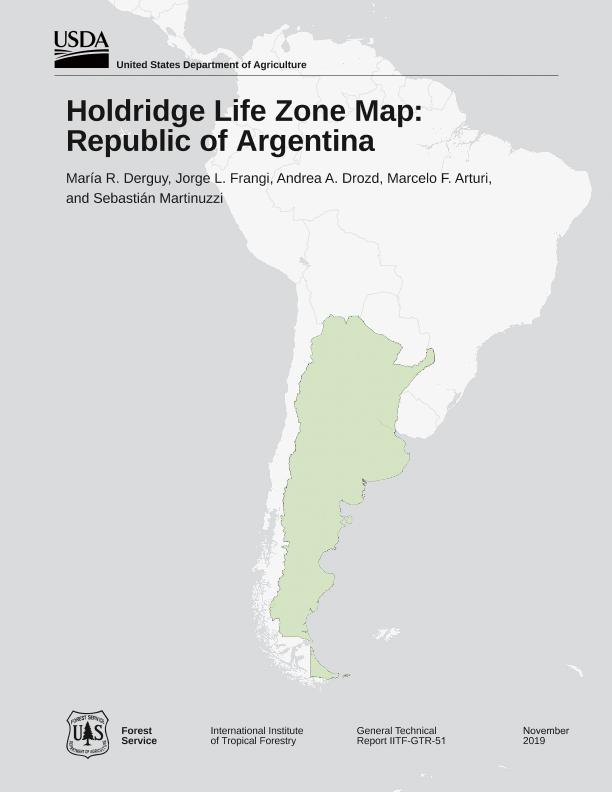Mostrar el registro sencillo del ítem
dc.contributor.author
Derguy, María Rosa

dc.contributor.author
Frangi, Jorge Luis

dc.contributor.author
Drozd, Andrea Alejandra

dc.contributor.author
Arturi, Marcelo Fabián

dc.contributor.author
Martinuzzi, Sebastián

dc.date.available
2022-10-31T05:33:49Z
dc.date.issued
2019-11
dc.identifier.citation
Derguy, María Rosa; Frangi, Jorge Luis; Drozd, Andrea Alejandra; Arturi, Marcelo Fabián; Martinuzzi, Sebastián; Holdridge Life Zone Map Republic of Argentina; United States Department of Agriculture; General Technical Report; 51; 11-2019; 1-48
dc.identifier.issn
0277-5786
dc.identifier.uri
http://hdl.handle.net/11336/175507
dc.description.abstract
Ecological zonation is a fundamental tool for territorial and ecosystem management. The Holdridge model is a system of ecological zoning based on the identification of bioclimatic units (life zones)that employs the variables of biotemperature, precipitation, potential evapotranspiration (EVT), EVT/P ratio, latitude, and altitude. Argentina displaysa high environmental variability. However, despite the completion of several comprehensive zonationsof intrinsicscientific value, the countrylacksanecological zonation withobjectively and precisely delimitedunits that may be repeated throughtime.The objective of this study was to identify and map the Holdridge life zones present in Argentina. Available climatic data wereintegrated at 1 km spatial resolution.The applied model revealed a highenvironmental heterogeneity, with a total of 83 life zones. Ofthis total, 72 corresponded to life zones in the original triangular model of 120 life zones described by Holdridge,and 11 were new life zones,extending the original model to a total of 131.The model recognized fivelatitudinal regions, from boreal to tropical,and sevenaltitudinal belts, from basal to nival.NorthwestArgentina contained the highest concentration of life zones.The life zones with the most geographic extent are Warm Temperate Dry Forest (15 percent of the nation)and Subtropical Dry Forest (9 percent), while Warm Temperate Alpine Wet Tundra and Subtropical Alpine WetTundra covered less than 0.1 percent.A wide range of biotemperatures, precipitation levels, and elevations,and their diverse combinations, explainwhy so manylife zones are present. Several factors influence climatic systems operating in Argentina,including itsgeographiclocation andnorth-south latitudinal extension (from about 21° to 55° S); the presence and characteristics of different portions of the Cordillera de los Andes (which reach elevations of up to 7000 m above sea level) in the west; the eastern lowlands; and the circumpolar oceanic current and related currents in the southern Pacific and southern AtlanticOceans.Application of the Holdridge system to Argentina resulted in an objective, detailed, and precise country bioclimatic zonation that highlights its environmental heterogeneity,which supports natural ecosystems, cultivated species,agriculture, forestry, and livestock production.This assessment can serve as a useful tool for evaluating the spatial evolution of climate change, land management and other socio-cultural aspects, biodiversity conservation, and other objectives.
dc.format
application/pdf
dc.language.iso
eng
dc.publisher
United States Department of Agriculture
dc.rights
info:eu-repo/semantics/openAccess
dc.rights.uri
https://creativecommons.org/licenses/by-nc-sa/2.5/ar/
dc.subject
Bioclimate of Argentina
dc.subject
Holdridge life zones
dc.subject
latitudinal regions
dc.subject
altitudinal belts
dc.subject
life zones richness
dc.subject
coverage and distribution
dc.subject.classification
Geografía Física

dc.subject.classification
Ciencias de la Tierra y relacionadas con el Medio Ambiente

dc.subject.classification
CIENCIAS NATURALES Y EXACTAS

dc.title
Holdridge Life Zone Map Republic of Argentina
dc.type
info:eu-repo/semantics/article
dc.type
info:ar-repo/semantics/artículo
dc.type
info:eu-repo/semantics/publishedVersion
dc.date.updated
2022-10-26T10:46:46Z
dc.journal.number
51
dc.journal.pagination
1-48
dc.journal.pais
Puerto Rico

dc.journal.ciudad
San Juan
dc.description.fil
Fil: Derguy, María Rosa. Universidad Nacional de Avellaneda. Departamento de Ciencias Ambientales; Argentina. Universidad Nacional de la Plata. Facultad de Ciencias Agrarias y Forestales. Laboratorio de Investigacion de Sistemas Ecologicos y Ambientales; Argentina. Consejo Nacional de Investigaciones Científicas y Técnicas; Argentina
dc.description.fil
Fil: Frangi, Jorge Luis. Universidad Nacional de la Plata. Facultad de Ciencias Agrarias y Forestales. Laboratorio de Investigacion de Sistemas Ecologicos y Ambientales; Argentina
dc.description.fil
Fil: Drozd, Andrea Alejandra. Universidad Nacional de la Plata. Facultad de Ciencias Agrarias y Forestales. Laboratorio de Investigacion de Sistemas Ecologicos y Ambientales; Argentina
dc.description.fil
Fil: Arturi, Marcelo Fabián. Universidad Nacional de la Plata. Facultad de Ciencias Agrarias y Forestales. Laboratorio de Investigacion de Sistemas Ecologicos y Ambientales; Argentina
dc.description.fil
Fil: Martinuzzi, Sebastián. University Of Wisconsin-madison. Silvis Lab; Estados Unidos
dc.journal.title
General Technical Report
dc.relation.alternativeid
info:eu-repo/semantics/altIdentifier/url/https://data.fs.usda.gov/research/pubs/iitf/iitf_gtr_51.pdf
Archivos asociados
